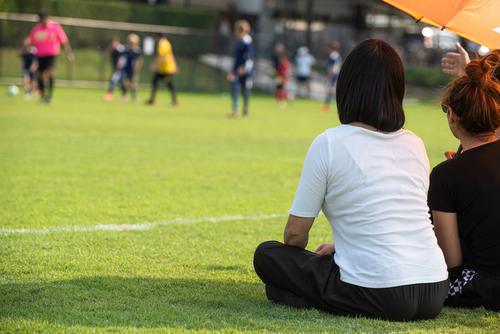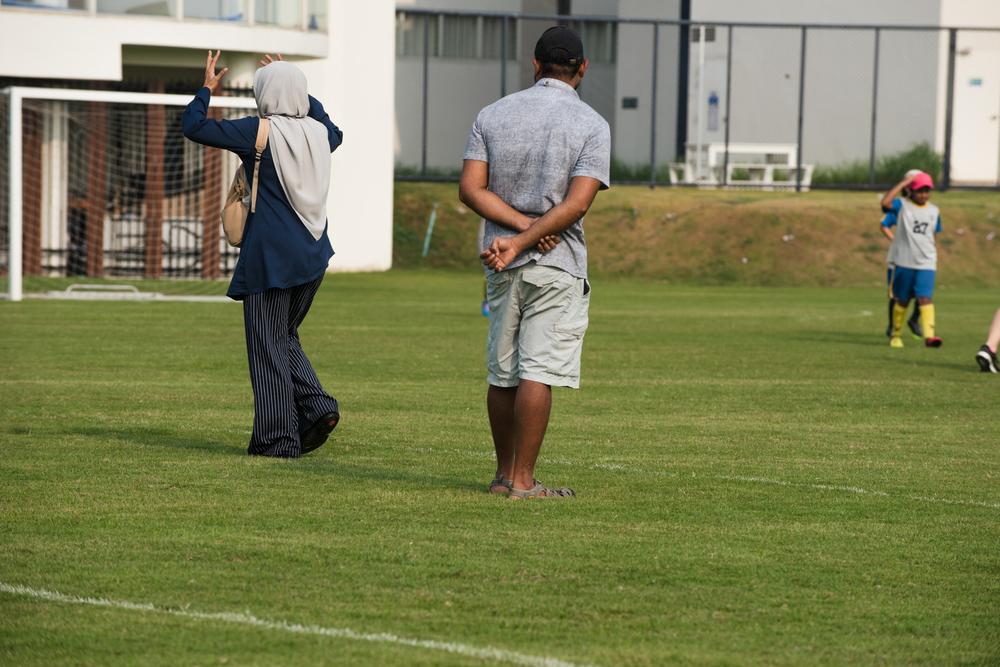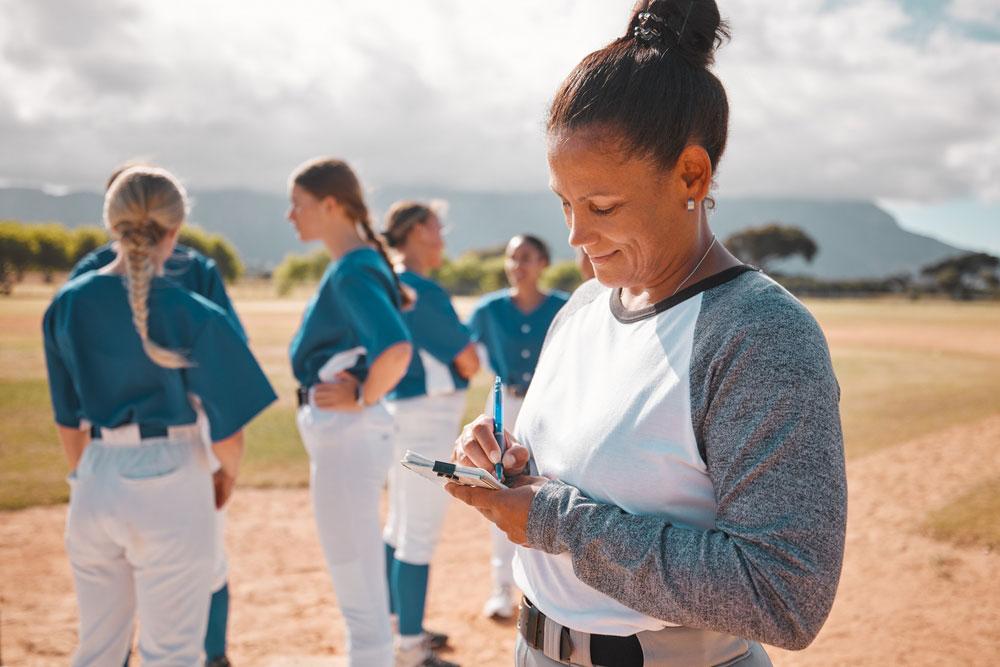 Have you ever stifled the urge to shout at a parent, referee, or player during a big game? As a coach, you probably know that it’s important to be a good role model for your young athletes. But what does that look like when you’re on the sidelines at a big game and your stress levels are skyrocketing?
Have you ever stifled the urge to shout at a parent, referee, or player during a big game? As a coach, you probably know that it’s important to be a good role model for your young athletes. But what does that look like when you’re on the sidelines at a big game and your stress levels are skyrocketing?
Dr. Amanda Stanec, who specializes in physical education and youth development through sport is a mother of three young athletes in addition to a coach educator. Here’s what she wants coaches to know about modeling good sportsmanship on gameday.
1. Cheer on effort, not just achievement
Rather than focusing on cheering hard when an athlete scores a goal in a game, try to cheer on moments of great effort. That could be when a child tries a new move—even if it doesn’t work out—or passes the ball to a teammate instead of trying to score a shot solo. “We need to really celebrate creativity and healthy risk-taking for athletes, not just moments where things go right and they score,” says Stanec. “We want kids to feel like they can try new things and take those risks. I hear a lot of coaches and parents make audible sighs or frustrated noises when an athlete misses a shot, and that just discourages athletes from trying anything new. There is no place for that on the sideline.”
2. Focus on the psychosocial dynamic
 If we focus on encouraging teamwork and community rather than on competition and winning, more young athletes will stay in sport, says Stanec. “I think if every coach went into sport with the goal of having every kid love their sport more at the end of season, that would be great for youth athletics,” says Stanec. “And they’ll like it more if they’re improving, if they’re learning and trying new things, and if they’re encouraged to have a good time while being competitive.” Focusing on a joyful and hardworking environment will undoubtedly lead to more development and wins.
If we focus on encouraging teamwork and community rather than on competition and winning, more young athletes will stay in sport, says Stanec. “I think if every coach went into sport with the goal of having every kid love their sport more at the end of season, that would be great for youth athletics,” says Stanec. “And they’ll like it more if they’re improving, if they’re learning and trying new things, and if they’re encouraged to have a good time while being competitive.” Focusing on a joyful and hardworking environment will undoubtedly lead to more development and wins.
3. Encourage cheering for everyone
As a coach, it’s important to remember to cheer for everyone, not just the star players or your favorite or most dominant personalities on a team. “To me, the golden rule is to give positive feedback to each individual player on your team,” says Stanec. “There’s been such an adult model of sport pushed on kids that it seems like now there’s a lot of competition and favoritism even within many youth teams.”
4. Be aware of negative language
“I think a great way to model good sportsmanship from the sidelines is not only by giving each player specific positive feedback, but also making it a rule to not criticize any child during the game, ever,” says Stanec. “Every kid knows when they make a mistake once they begin playing at more competitive levels, so whether you’re a coach or a parent, during a game is not the time to bring it up.” If there’s a skill-based technique or tactic that the athlete can work on, a coach can make a note to bring it up in practice, but the heat of the moment during a game isn’t the time to get into it.
5. Cheer for the other team
 Coaches (and parents) can influence how your team sees and treats players on opposing teams by cheering for those kids as well. “I like to cheer for the other team when a great play is made,” says Stanec. “Saying things like great shot, great save—those small things can make a big difference in attitudes from the opposing team’s athletes, coaches, and parents, while also making games much more fun, even while remaining highly competitive.” And cheering for great plays from the other team as a coach can also cue your own athletes into great tips and tactics that they may not have noticed before. Showing appreciation for the game and all the joy it can bring is something that ought to be celebrated.
Coaches (and parents) can influence how your team sees and treats players on opposing teams by cheering for those kids as well. “I like to cheer for the other team when a great play is made,” says Stanec. “Saying things like great shot, great save—those small things can make a big difference in attitudes from the opposing team’s athletes, coaches, and parents, while also making games much more fun, even while remaining highly competitive.” And cheering for great plays from the other team as a coach can also cue your own athletes into great tips and tactics that they may not have noticed before. Showing appreciation for the game and all the joy it can bring is something that ought to be celebrated.
6. Coaches should set the tone with parents
“It can be so helpful to have a meeting with parents at the beginning of the season to set standards for what’s appropriate at games,” Stanec says. “Let them know that the only thing you want to hear from them during a game is positive encouragement like ‘great hustle,’ or ‘great try.’ No coaching the coaches, no coaching the athletes.” You can even ask the athletes themselves to come up with a Code of Good Sportsmanship that encompasses the team’s positive values for coaches, parents, and the athletes themselves. Get everyone to sign this code at the start of the season.
7. Pay attention to your body language
 You may not realize that your body language unconsciously is sending negative messages, but if you’re constantly shaking your head, covering your eyes, looking down, gesturing wildly, or just showing closed off body language, you may be sending unintentional nonverbal cues to the athletes, says Stanec. If you aren’t sure how you’re appearing at games, consider asking someone to video you for a few minutes, then play the footage back to see how you handle different moments. Focus on positive body language like cheering, smiling, making eye contact, and generally keeping your body relaxed and open.
You may not realize that your body language unconsciously is sending negative messages, but if you’re constantly shaking your head, covering your eyes, looking down, gesturing wildly, or just showing closed off body language, you may be sending unintentional nonverbal cues to the athletes, says Stanec. If you aren’t sure how you’re appearing at games, consider asking someone to video you for a few minutes, then play the footage back to see how you handle different moments. Focus on positive body language like cheering, smiling, making eye contact, and generally keeping your body relaxed and open.
8. Roleplay high-stress scenarios
A great way to model good sportsmanship—and prevent potential emotionally fraught moments in the game—is by roleplaying different high-stress situations. Ask yourself, how would you respond if someone does something disrespectful during the game, or makes you angry? Now, picture how your response would look if someone captured it on video and posted it online. Would you be okay with that reaction being posted? If not, what could you do instead? Preparing yourself by ‘rehearsing’ these scenarios can make a big difference to your reactions in the moment. Do this activity with your athletes or just as a personal exercise.
9. Remember that kids absorb everything
The areas that control logic and rational thought are some of the last to receive a circuit update in an adolescent’s brain, says Stanec. That means it may be harder for them to control their emotions, and if they see you engaging in unsportsmanlike behavior, from cursing under your breath at the umpire to shouting at a parent on the opposing team, they begin to emulate that reaction. “These unsportsmanlike behaviors are taught,” says Stanec.
___________________
TAKEAWAY: When athletes look at their coach during a game, they should see positivity and encouragement, not frustration or anger. Athletes also shouldn’t see you arguing with referees or exhibiting negative body language. Remember, how you act determines how your athletes act.



